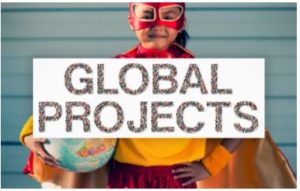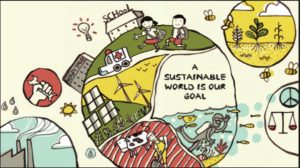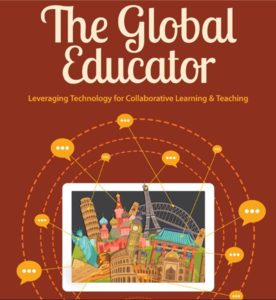Creating global projects got me thinking about the groundwork that should be covered before the connections with strangers can become a viable means to exploring global perspective. Finding global projects to explore the world through experiences that spark curiosity and intercultural opportunities is not difficult. The challenging part is building inter and intrapersonal skills beforehand; the skills to ensure mutual kindness, empathy, and deep learning. If trust and respect are not formed, collaborations are destined to be somewhat superficial and shallow attempts to build global competency. This requires considered preparation. I found a website that is designed to foster meaningful connections among students, by doing just that-attending to the soft skills that are essential for successful global collaboration.
global education
Global Projects made easy
The links to the Global projects (roll cursor over) are now being added.
The projects include a selection fr om by Flat Connections, iEARN, Microsoft Education, Global Education, Deforest Action, Natural Disaster Youth Summit, and Kids Can Make a Difference. Thank you to all these organisations for laying the groundwork for teachers and students to become global citizens by communicating, collaborating, and creating new ideas and concepts using digital technology.
om by Flat Connections, iEARN, Microsoft Education, Global Education, Deforest Action, Natural Disaster Youth Summit, and Kids Can Make a Difference. Thank you to all these organisations for laying the groundwork for teachers and students to become global citizens by communicating, collaborating, and creating new ideas and concepts using digital technology.
Welcome to Global Projects
Please excuse my excitement as I share something that I’m proud of.
Welcome to Global Projects

The global economy and technology are transforming the Australian economy and society. The work people do is changing and in order to prosper, skills need to be adapted.
Our workforce is going global and the global workforce is coming to us. Young Australians need global competencies to live and work all over the world in global teams with global clients.
Global Projects help teachers to plan for meaningful deep learning experiences that develop global competencies. They enable the investigation of global events, with many referring to the UN Sustainable Development Goals, answering the call for global citizens who can make a difference in their lives and the lives of others.
Global projects allow teachers to incorporate multiple learning areas, teach the Victorian Capabilities in an authentic context and provide opportunities for students to have agency over their learning.
These projects have been sourced from across the globe and will shortly be published with alignment to the Victorian Curriculum. The work has been done for you. Keep a watch out!
For more information about Global Projects and the implementation in your classroom
contact marilyn@bethinkglobal.com.au
Error: Contact form not found.
Bethink Global brings global issues to the curriculum in an exciting and positive call for globally competent learners
What makes a good life?-eradicating poverty and promoting prosperity in a changing world
I’ve been reading about education as a tool of democracy and a conduit to connect learners to broader social issues. It made me think about how to learners in their world of sufficiency, could have a better and more empathic understanding of people who live in poverty.
What could a lesson look like in the classroom?
Background
$1.90 per person per day is the standard adopted by the World Bank and other international organizations to reflect the minimum consumption and income level needed to meet a person’s basic needs.
That means that people who fall under that poverty line—that’s 1/8 of the world’s population, or 767 million people—lack the ability to fulfill basic needs, whether it means eating only one bowl of rice a day or forgoing health care when it’s needed most.
The purpose of this activity is for students to raise questions and clarify their own thoughts about what things are most important to having a good life. They may also begin to see that although people living in poverty are lacking many material things, their lives may also include some aspects that the students value. This thinking will be important as students learn more about experiences of poverty.
Activity – The Good Life Road
Tell students that they will be considering what makes a good life. First, watch or read a stimulus resource as a class (such as Herbert and Harry by Pamela Allen, The Short and Incredibly Happy Life of Riley by Colin Thompson, or the TEAR video, Working Together in an Indian Village
Divide students into groups of four or five and give each group a set of cards with the following phrases on them. (They are available to print at the Global Education website ) It is helpful if each card can be printed in a different colour.
Having clean water and toilets
Having jobs for adults
Having friends and family who love and help you
Being able to make choices about what happens in your life
Having a safe place to live
Having TVs, computers and other electronic stuff
A government that helps if you need it
Getting an education
Having lots of money
Being healthy
Having great toys
Having fashionable clothes
Being famous
In their groups, students read through the cards and make a decision about how necessary each item is for a person to have a good life. They should place each card along the Good Life Road, a line marked on the ground with ends marked ‘Very important’ and ‘Not important at all’. The cards should be positioned according to how important students think the item on the card is to having a good life. For example, if the group thinks the item on the card is vital to having a good life they should place it at the ‘Very important’ end, or if they think it is not important they should place it at the ‘Not important at all’ end. They can also place cards at any point in between
Discussion
When the groups have finished, the whole class should look at the continuum. The different coloured cards will help them to notice any trends across the cards from different groups. Students can comment on why they agree or disagree with the placement of particular items.
Is there general agreement within the class about particular items?
Are there differences between the class’s answers and what they think other people may say about a good life?
Do students’ lives actually reflect the things they say are important?
Are there any connections between the thinking in this activity and the people/characters in the book or video they viewed previously?
Do they think that people living in poverty are able to have a good life?
Can students think of anything they have in common with people living in poverty?
With thanks to the One World Centre.
The 2030 Agenda for Sustainable Development: a different strategy for a different time
….the rise of political parties whose platforms thrive on nationalism, protectionism and xenophobia, strayi further & further away from traditions of tolerance & inclusiveness in democratic societies….
The requirement for global citizenship to be part of the education system is an imperative in a changing world. Our young ones deserve our thoughtful preparation for the issues set up on our watch.
https://sustainabledevelopment.un.org/hlpf/blog2017/week19_2030agenda
What makes a great global project?
As part of Global Leadership Week I’m took my first steps to enter the real time world of connected learning.
I was to start a Twitter Chat on Global Projects using the hashtag @globalprojects
Now if you’ve hosted a real time chat you’ll know that countdown time is quite a tense one. Is everything in place. Will I sound cool? Will I have followers?
But just 15 minutes before my start time I decided to search my hashtag. Yes, it had already been used, which meant I’d be bringing people into the discussion who would have no idea what I was doing. Mad rush to change that hashtag to … #glopro This one sounded on trend! Continue reading
Working out loud
You’ve got to love what digital connection and social tools can do.
I recently reached out on LinkedIn to broaden my professional learning network and connected with Ciarra Greene at Portland University, Oregon. I asked Ciarra about global education and her reply set me thinking. I had an ‘aha’ moment. She gave me the missing dots to connect so many ideas rushing about in my head. Ciarra mentioned place-based learning and whilst I understood the concept I had not heard that name.
Place-based learning immerses students in local heritage, cultures, landscapes, opportunities and experiences, using these as a foundation for the study of other learning areas across the curriculum.
I immediately thought of My Place by Nadine Wheatley and the wonderful offerings for learners relating to PLACE. I’ve wandered from my original pathway!
Ciarra is connected to the Nez Perce tribe, who are an Indigenous people of the plateau, living in the Pacific northwest region of the United States.

Indigenous tribes in the USA are in the news right now, battling Trump’s directive to the Army to continue laying the Dakota Access pipeline across sacred sites with the threat of contaminating drinking water.
What if learners in the United States exchanged their understandings of the traditional cultures of indigenous tribes with learners in Australia and their understandings of the traditional cultures of our First People, the Aborigines? What if the identity and indeed existence of these indigenous tribes was being threatened? What if environmental issues are being exploited?
I think Ciarra and I are learning just in the same way we want our young learners to learn-through collaboration, communication and deep thinking. Through technology, our learning has shot past the four walls of the classroom and entered the biggest ‘classroom’ that is our world.
How amazing!
The A in STEAM and climate change.
 We are hearing much about STEM but I’m advocating for the rightful inclusion of the Arts and a place for STEAM.
We are hearing much about STEM but I’m advocating for the rightful inclusion of the Arts and a place for STEAM.
I am wanting to hear from schools where leadership and educators have supported their learners to respond artistically to the issues surrounding climate change. This may be in the form of the visual arts, music, theatre, dance, literature and or cinema.
Hoping to be proven wrong, it is my feeling that educators do not highlight climate change in the curriculum. It’s not a hot topic (pardon the pun). Traditionally slotted into the curriculum under Science and Geography, many educators are insufficiently informed, too fearful of tackling what they see as a controversial topic or both. The links to many issues of global significance can be traced to the warming of the planet.
In the sphere beyond the classroom I’ve come across a group called CLIMARTE and a theatre troupe called ClimActs.
CLIMARTE’S mission is to harness the creative power of the arts to inform, engage and inspire action on climate change. Climarte will present their ART+CLIMATE=CHANGE 2017 festival which will run from 19 April to 14 May 2017.
ClimActs is an Australian theatre troupe playing a role of peaceful protest to support demands for social justice and human rights. Using striking spectacle as well as satire to communicate and educate on the urgency of climate change, each act has been carefully created to address an aspect of the climate debate. For instance, the Climate Guardians represent selfless and fearless care and guardianship, the Coal Diggers epitomise the recklessness and insatiable greed of vested interests.
 The Climate Guardian Angels in peaceful protest at the COP21 talks in Paris 2015
The Climate Guardian Angels in peaceful protest at the COP21 talks in Paris 2015
School leaders and educators, don’t forget the A in STEAM and broaden the opportunities for young people to find their voice and respond to the concerns of their generation.
Don’t forget to contact me if your school is already taking this approach.
Marilyn Snider is an Australian global education activist who promotes a dynamic, self-directed approach where learners explore real world issues and challenges whilst delving into deeper and more satisfying conceptual understandings. Creativity, critical analysis and action are hallmarks of her work. www.bethinkglobal.com.au
What works for me… and us!
There are so many exciting experiences happening in classrooms all over the world. Ordinary teachers doing amazing things with their learners at the heart of each experience-professional learning networks of teachers willing to share in order to strengthen the skills and awareness of their learners. You’ll find digital and/or global learning examples right here in this posting.
Colleague, Julie Lindsay, of Flat Connections constructs a learning model whereby all learners have freedom to communicate across borders rather than up or down – with no hierarchy.
On Global Collaboration Day (15th September), experienced global educators and professionals will host connective projects and events. The goals of this whole day event are to demonstrate the power of global connectivity in classrooms, schools and universities around the world, and to introduce others to the tools, resources and projects that are available to educators today.
Take a look at the active global projects from iEARN. This organisation enables interactive curriculum-based groups to create, research, share opinions and become global citizens.
How can you engage your learners in learning about the world from the world?
The Global Educator
My col league, Julie Lindsay, has just published her new book, The Global Educator. When Julie put out the request for input from global educators across the world I was only too happy to oblige.
league, Julie Lindsay, has just published her new book, The Global Educator. When Julie put out the request for input from global educators across the world I was only too happy to oblige.
Marilyn, Australia, says, “I’d like to see all schools in Australia become global learning hubs—places where the process of learning is connected, collaborative and communicated in as many ways as possible, to many interested learners in local, national and global communities, through the use of tools for social learning. Here we are challenged by the availability of reliable connectivity for all global communities, available education hubs for all learners and the proficiency of teachers to enable global and connected learning to take place in their schools. Changes to the traditional thinking behind the delivery of education—the buildings, rooms, the blended learning model, the flattening of classrooms, the pedagogies involved—these are all part of providing a conducive environment for global learning” (Marilyn Snider, @malmade1).
As Marilyn Snider, Senior Global Consultant, Australia, shares with us, “As a global education leader I promote open-mindedness leading to new thinking about the world and a predisposition to take action for change. Taking responsibility for their actions, learners come to respect and value diversity, and see themselves as global citizens who can contribute to a more peaceful, just and sustainable world. Enabling young people to participate in a better-shared future for all is at the heart of global education. In terms of impact, my perspectives of the world infuse my thoughts and ideas on a daily basis. I am more perceptive, more analytical, more understanding. I can see many angles to a story. My input is thoughtfully constructed with attention to identity, cultural diversity, human rights, social justice, and peace with its counter side, conflict resolution.”
Julie Lindsay’s book, The Global Educator, is a collaborative effort and a fine example of social tools for learning in use.

